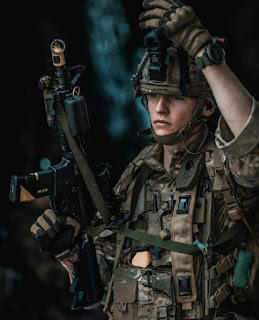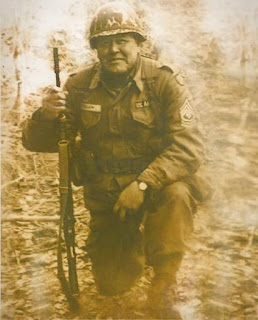The Royal Marines are a fearsome and highly respected unit who abide to the original Commando Values.
Royal Marine Commandos:
The Royal Marines are a fearsome and highly respected unit who abide to the original Commando Values.
Royal Marines are a maritime-focused, amphibious, highly specialised light infantry force who are capable of deploying at short notice anywhere in the world. As the United Kingdom Armed Forces’ specialists in cold weather warfare, Royal Marines provide lead element expertise in the NATO Northern Flank and are optimised for high altitude operations, with jungle training still carried out when deployments allows. The selection process for becoming a Royal Marines Commando is extremely tough.
There is a very good reason why the Corp has used the strap line “99.9% need not apply” in a recruitment campaign. It is aimed at attracting the right type of person who has the potential to join this elite unit. Being a Royal Marines Commando is about having the right attitude, the right level of professionalism and also the right level of physical and mental fitness.
In order to become a Royal Marine and earn the right to wear the much-coveted Green Beret, you will need to pass a rigorous selection process.
Training:
Prospective candidates must be 16 to 33 years old and undergo interviews and a physical assessment to include the following:
Two 1.5 mile runs, the 1st under 12 minutes 30 seconds, followed by a one-minute break, and the 2nd must begin and complete in less than 10 minutes. All of this is done on a treadmill with a 2 degree incline.
After completing this, enlisted men attend a three day Potential Royal Marine Course (PRMC), while officers take the Potential Officer Course (POC), at Commando Training Center Royal Marines (CTC) in Lympstone, England.
Here, a final battery of physical and mental tests are conducted including 3-mile timed runs, 2.5 mile obstacle course, strength tests (60 pressups, 80 situps, and minimum of 3 pullups), along with a swimming test. All must show good form or the candidate may be failed.
If passed, a recruit is issued a pair of socks and boots, along with a certificate entitling them to join recruit training.
Now, for the enlisted, a rigorous 32 weeks begins. Officers will do 64.
NATO’s longest infantry training starts with the 1st phase, known as Initial Training. Officers alongside enlisted must endure lengthy daily drills consisting of physical and mental conditioning, field craft, parade ground, small unit tactics, weapons efficiency, and traditions and history of the Corps.
2nd phase is Military Training, operating in teams from 8 to 28, speed marches with up to 70 pounds on backs plus air and cliff assaults taking place in the rugged landscapes of CTC, Dartmoor and Woodbury Common.
3rd phase is Amphibious Training, learning how to use rafts, small boats and landing craft for raids and familiarization with the Special Boat Service.
4th phase comes in the closing weeks, when they enter the signature Commando Course. Wearing standard kit including 32 pound rucksack, recruits must complete the following events:
9 mile speed march completed in 90 minutes (10 minutes per mile)
The Endurance Course at Woodbury Common, stretching 6 miles of rugged terrain with pipes, tunnels, wading pools and underwater culvert. 4 mile run back to base with a marksmanship test where 6 of 10 hits must be achieved on a 25meter target representing 200 meters. The combined time to complete the course is 73 minutes.
The Tarzan Assault Course starting with a Commando slide down a zip line, rope climb up 34 foot wall, to be completed in 13 minutes for enlisted, 12 for officers.
The final test is the 30 miler. This route takes them through the rolling and jagged highlands of Dartmoor with additional weight of safety equipment added. Enlisted must complete the march in 8 hours, the officers in 7.
Upon completion of the Commando Course, the privilege of wearing the symbol of the Corps, the Green Beret, is granted.
Royal Marines On Patrol In AfghanistanOnly 1 in 5 make it this far. (As an interesting fact, Queen Elizabeth’s son, Edward, tried but failed to become an RM Commando.)
It’s still not over, as the training team does a final assessment of the recruit’s skills and qualifications to see if they pass.
If they do, they find themselves in the last week designated ‘The King’s Squad,’ with their own section of the recruits galley. A pass out parade is held, and the Marine receives assignment to 3 commando brigade for a period as a general duties rifleman.
History:
In 1940, the British Army also formed "independent companies", later reformed as battalion sized "commandos", thereby reviving the word. The British intended that their commandos be small, highly mobile surprise raiding and reconnaissance forces. They intended them to carry all they needed and not remain in field operations for more than 36 hours. Army Commandos were all volunteers selected from existing soldiers still in Britain.
During the war the British Army Commandos spawned several other famous British units such as the Special Air Service, the Special Boat Service and the Parachute Regiment. The British Army Commandos themselves were never regimented and were disbanded at the end of the war.
The Special Operations Executive (SOE) also formed commando units from British and displaced European personnel (e.g., Cichociemni) to conduct raiding operations in occupied Europe. They also worked in small teams, such as the SAS, which was composed of ten or fewer commandos because that was better for special operations. One example is Norwegian Independent Company 1, which destroyed heavy water facilities in Norway in 1941.
The Royal Navy also controlled Royal Navy Beach Parties, based on teams formed to control the evacuation of Dunkirk in 1940. These were later known simply as RN Commandos, and they did not see action until they successfully fought for control of the landing beaches (as in the disastrous Dieppe Raid of 19 August 1942). The RN Commandos, including Commando "W" from the Royal Canadian Navy, saw action on D-Day.
In 1942, the Royal Navy's nine Royal Marines infantry battalions were reorganized as Commandos, numbered from 40 to 48, joining the British Army Commandos in combined Commando Brigades. After the war the Army Commandos were disbanded. The Royal Marines form an enduring Brigade-strength capability as 3 Commando Brigade with supporting Army units.
The Royal Air Force also formed 15 commando units in 1942, each of which was 150 strong. These units consisted of trained technicians, armourers and maintainers who had volunteered to undertake the commando course. These RAF commandos accompanied the Allied invasion forces in all theatres; their main role was to allow the forward operation of friendly fighters by servicing and arming them from captured air fields. However, due to the forward position of these airfields, the Royal Air Force Commandos were also trained to secure and make safe these airfields and to help defend them from enemy counterattack.
Formation:
3 Commando Brigade
The Royal Marine Commandos (or 'Bootnecks' as they call themselves), in the form of 3 Commando Brigade, are a key element of the UK's Rapid Reaction Force.
The Commandos
The primary fighting elements of the Royal Marines are the battalion-sized Commando units.
40 Commando
(based at Norton Manor Barracks, Taunton, Somerset)
45 Commando
(based at Condor Barracks, Arbroath, Angus, Scotland)
Each Commando is organised into 6 companies. Each company is made up of platoon-sized Troops:
> 1 Command Company:-
* Main HQ
* Tactical HQ
* Reconnaissance Troop (includes a sniper section)
* Signals Troop
* Mortar Troop
(9 x 81mm mortars + 4 Mortar Fire Control parties)
* Anti-Tank (AT) Troop
(6 x Javelin)
* Medium Machine Gun Troop
(6 x GPMG (SF mode)
> 1 Logistic Company:
* A Echelon 1 (A Ech1)-
* A Echelon 2 (A Ech2)
* Forward Repair Team (FRT)
* Regimental Aid Post (RAP)
* B Echelon (B Ech)
> 2 Close Combat Companies :
* Company Headquarters
(Coy HQ)
* 3 Close Combat Troops
(Troop HQ, 3 Rifle Sections, Manoeuvre Support Section)
* 2 Stand Off Companies
(1 x tracked, 1 x wheeled)
consisting of :
Company Headquarters (Coy HQ)
Heavy Machine Gun Troop
(6 x HMG / GMG)
AT Troop
(6 x Javelin)
1x Close Combat Troop
(5 officers + 78 other ranks)
42 Commando - Maritime Operations Commando:
42 Commando are a specialist maritime operations unit. Roles include force protection, personnel recovery, counter terrorism and maritime interdiction.
Juliet Company 42 Commando deploys specialist boarding and sniper teams:
Fleet Contingency Troop
Maritime Sniper Team
Special Forces Support
1 company (F Coy) of Royal Marines are assigned to the Special Forces Support Group (SFSG).
Mountain Leaders
Each commando battalion contains specialists in mountain and arctic warfare, known as Mountain Leaders (MLs). Mountain Leaders are proficient in cliff assaults, high altitude warfare and skiing.
Vehicles:
The Royal Marines employ some specialised vehicles. These include:
MWMIK - armoured 4x4 all-terrain vehicles used in the fire support and recon roles
Land Rover WMIKs - heavily armed but lightly armoured vehicles used for long range reconnaissance and fire support (largely replaced by the new MWMIK)
Pinzgauer 4x4s - rugged and nimble troop carriers in use in Afghanistan
all-terrain-vehicles (ATV)s - tracked vehicles designed to transport men and equipment over all kinds of ground. These include the BVS 10 Viking and BV206D.
Watercraft
The Royal Marines operate a range of watercraft:
rigid raiders
rigid inflatables (RIBS)
offshore raiding craft
inflatable raiding craft
LCU / LCVP landing craft
LCAC hovercraft
Royal Marines Selection & Training:
The Royal Marines go through extensive training. An initial selection period is followed by a 32 week training program.
Royal Marines Special Units:-
There are several specialised RM sub units...
Fleet Protection Group Royal Marines:
A special cadre of Royal Marines tasked with fleet and nuclear security.
Brigade Patrol Troop (Brigade Reconnaissance Force)
3 Commando Brigade's elite reconnaissance force.
The Special Boat Service (SBS)
Drawn mostly from RM ranks, but technically under the command of the Directorate of Special Forces and part of UKSF, the SBS is a special forces unit on a par with the army's SAS.
Roles of the SBS include Maritime Counter-Terrorism, beach and shore reconnaissance, drug smuggling interdiction and behind the lines reconnaissance and sabotage missions.
Royal Marines Reserves (RMR)
The regular Commandos are augmented by fully trained civlian volunteers from 5 RMR units
Other Royal Marines Units
1 Assault Group Royal Marines (1 AGRM)























Comments
Post a Comment